Navigating the Mysteries of ‘Life And Trust’ (A NoPro Review Crew Convo)
NYC Curator Allie Marotta and NYC correspondent Joey Sims dive deep into their experience at NYC’s most talked about show
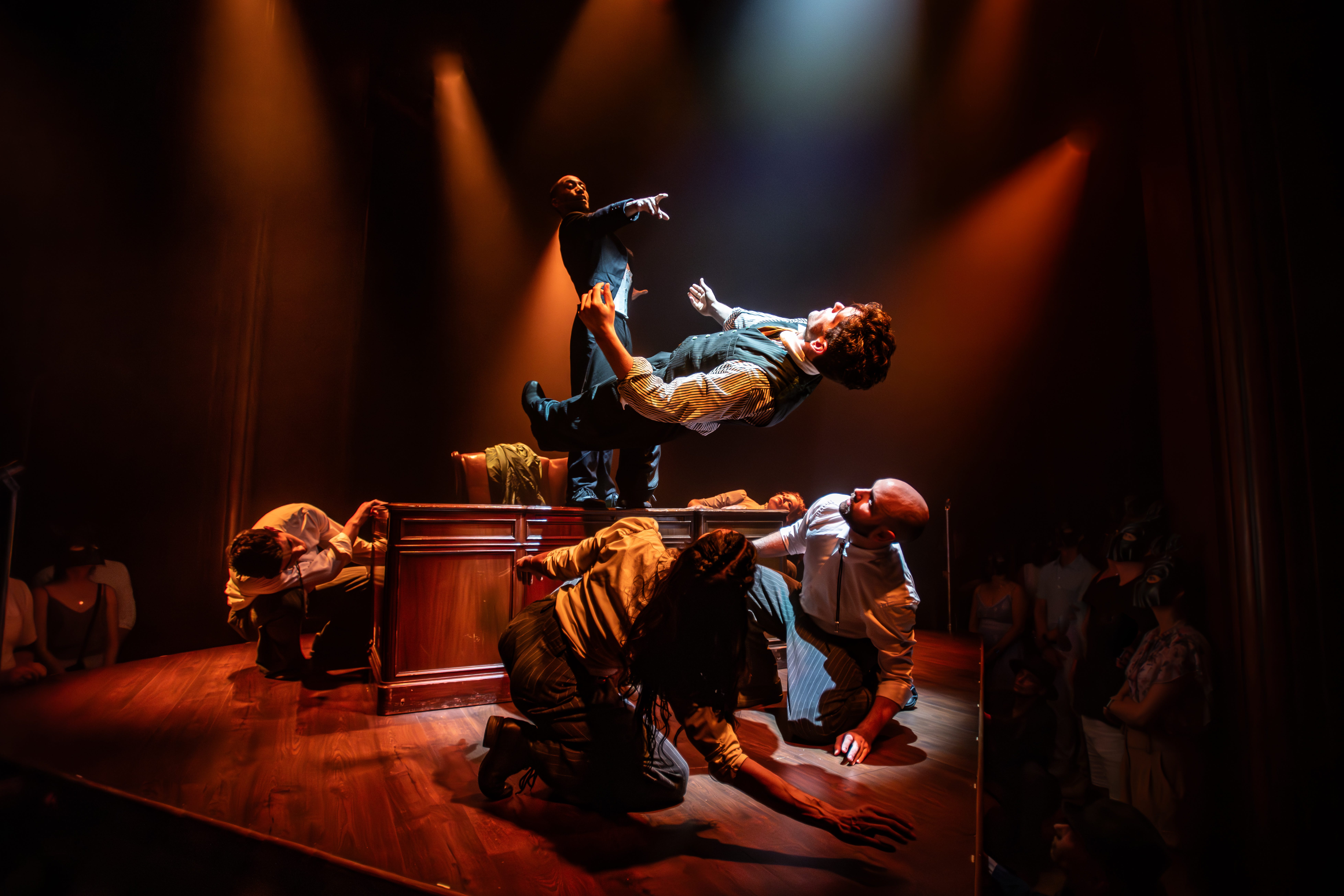

No Proscenium NYC Curator Allie Marotta and NYC correspondent Joey Sims experienced Emursive Productions’ newest immersive experience Life And Trust on Monday, August 19th. This dance-based, sandbox-style, choose-your-own-adventure piece further mines the form made most popular by Punchdrunk’s Sleep No More (presented in New York by Emursive, and still running, as of this writing, through October 23) that has been replicated and further developed by various artists ever since. Life And Trust is directed by Teddy Bergman (K-Pop), designed by Gabriel Hainer Evansohn, and choreographed by Jeff & Rick Kuperman (The Outsiders).
Read on for Allie & Joey’s take on all things Life And Trust including details about their individual experiences and discussions of character development, set design, storyline, and accessibility.
INTROS & BACKGROUND KNOWLEDGE
JOEY SIMS: So, Allie. How much familiarity were you coming into Life And Trust with? What had you heard?
ALLIE MAROTTA: I’m familiar with Emursive’s work, the source material of Faust and the 1920s era, and I’m familiar with the form. So I feel like I had a pretty solid basis going into it. How about you?
JOEY: Somehow I have never seen Sleep No More. What immersive shows I have seen, like Immersive Great Gatsby, are maybe not the best representations of the form. So I was not going in with a lot of familiarity with the “rules,” or how these shows tend to loop. Which is knowledge that can shape how you choose to interact with a show like this.
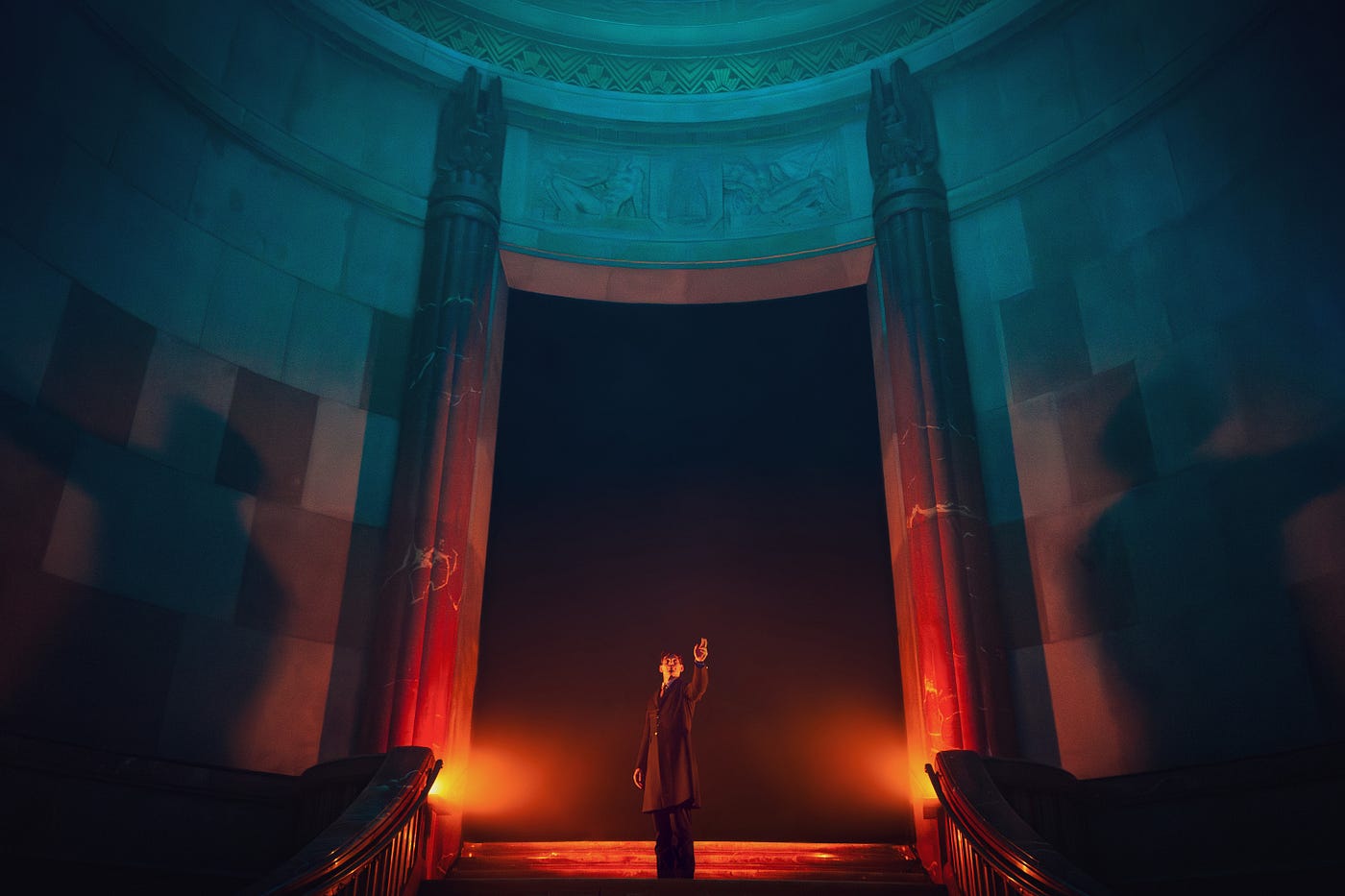
BEGINNINGS AND EARLY WANDERINGS
JOEY: Everyone starts on the same scene with J.G. Conwell, the only dialogue-based scene in the show. An older Conwell tells us that his fortune was built on some mystery elixir, but all that success is about to end with the Wall Street Crash of 1929. He is visited by Mephistopheles — the devil — who makes an offer that, honestly, I had trouble fully grasping.
I think the deal was: I will allow you to relive your glory days at the height of American wealth and expansion in the 1920s. For some vaguely defined period of time. And then, your soul belongs to me.
Following that scene we move into the space, and the show becomes self-guided. How did you start out?
ALLIE: I always need to start by just having a roam, having a wander, to get a sense of the layout of the space. I did that for maybe the first 20 minutes. Then I did some light tailing of a few characters. No one grabbed me right away, but I ended up staying with a character who I think was a Scientist because we spent a lot of time in a laboratory. I came in just slightly into the beginning of her track, and I followed it for a full loop.
After that, I went for another wander. I spent some time in a space that I really wanted to see activated: a hut made of interwoven twigs and hay, tucked away within what appeared to be an opium garden. I thought so many cool things could happen there, but not much did.
What journey did you go on?
JOEY: I just followed my id and wandered freely the whole time. Which, if I had known more, maybe I wouldn’t have done. So for me, the show was very fragmented, like shooting chaotically through Conwell’s dreamscape rather than following any sort of narrative.
Did you ever feel like you were following any kind of story?
SEEKING A NARRATIVE
ALLIE: When I followed the one track, yes, there was a super clear story with a throughline. But it didn’t have very much to do with Conwell. This Scientist was definitely a side character.
There is a conceit in the show of this magic potion made from poppies, from which Conwell made his fortune. This Scientist was, I think, working on figuring out the recipe to Conwell’s concoction, which presumably is secret. Even though Conwell bought it from a traveling magician.
She had this magician partner — a romantic partner, it seemed — whose act was to escape electrocution while tied up in a straightjacket. One of the coolest scenes I did see was a magic trick where they get wrapped up and ‘electrocuted’ and then escape. That was pretty cool — it leaned a lot into spectacle, which was nice to see.
Conwell came in a little bit, he tried to steal the formula from her at one point, but his involvement was pretty minimal in that track.
JOEY: Conwell is the source of the opioid, and all of these people we come across are suffering the wider impact of his drug and his vast empire. At least, that seems to be what’s connecting it all, right?
ALLIE: I think that’s the idea. I’m not actually sure, though, what the Conwell storyline is? So it’s hard to say. What did you glean from the bits and pieces you saw?
JOEY: In terms of Conwell’s story, I didn’t track anything clearly. I did get one big emotional moment that sticks out, him watching a woman perform a fraught dance in the vaudeville theater. As he watched, there was clearly an intense connection between them. I think she was in love with him. He watched her mournfully and then left. I didn’t totally grasp who she was, though.
ALLIE: That definitely seems to be a theme. I didn’t fully grasp who this character was that I was following. It was not like Sleep No More where the characters of Macbeth are very clear. Or in Burnt City, as another example, the Greek mythological figures are pretty familiar to most people.
This was an entirely fictionalized story with new characters that we’re not familiar with, and that character building was not provided in the at-a-glance format that you get when you’re moving from scene to scene. I only learned so much about this Scientist because I stayed with her for one track. The other characters passing through, I had no clue.
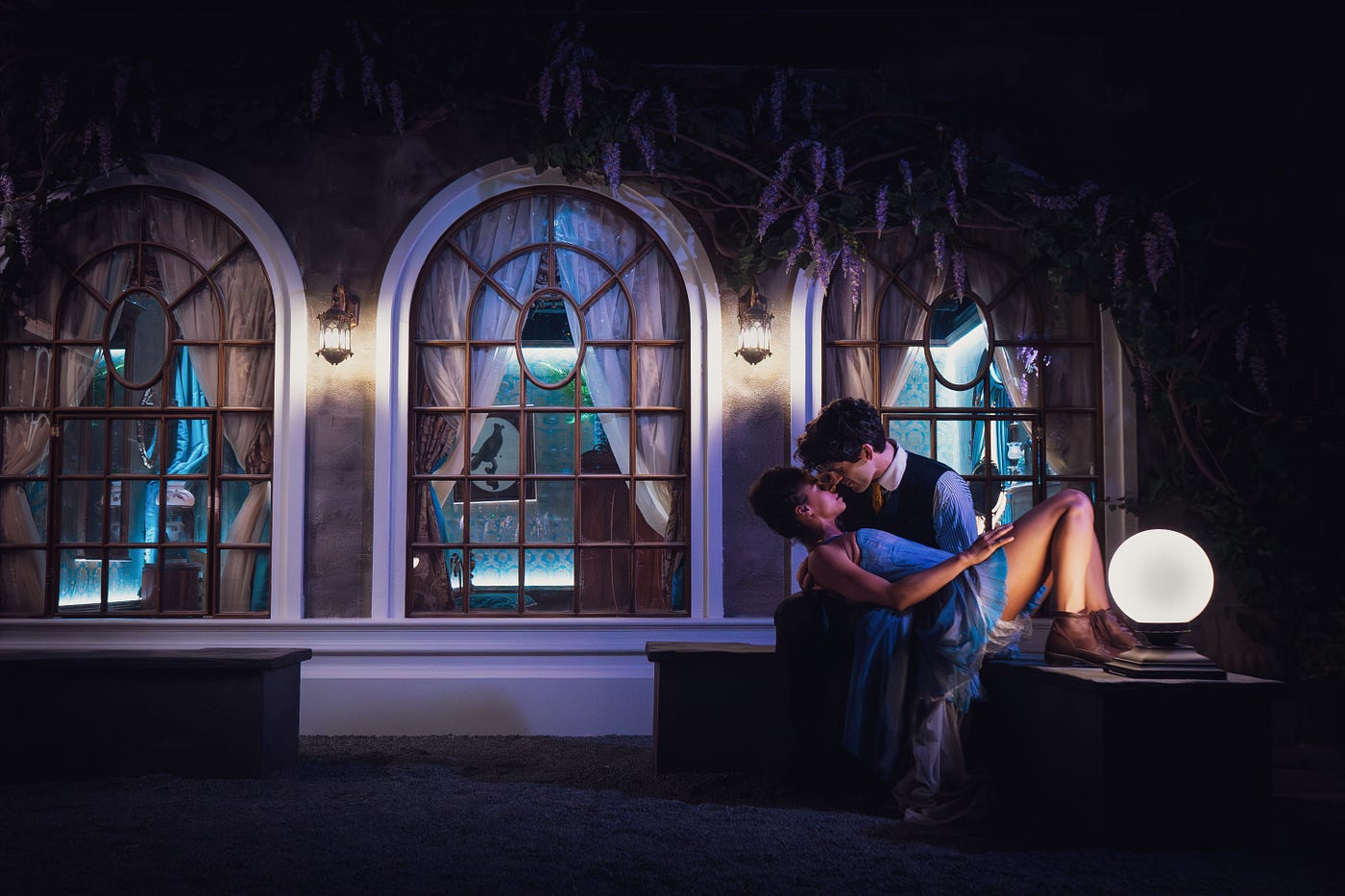
ONE-ON-ONES & SOAKING IN THE SPACE
JOEY: Did you have any one-on-ones?
ALLIE: I did not, and I didn’t see other people having them either. Which was disappointing.
JOEY: I did not either. But again, speaking to the quieter moments that I did like — I did have a moment where I was alone with the Boxer, the one who loses the fight early on, I had a moment with him in the garden after a lover rejects and leaves him. A lot of lovers rejecting and leaving people, by the way! So much doomed love. And I just sat with him as he stood there alone, crying and devastated. I did enjoy that moment of just having that quiet intimacy with that performer.
ALLIE: That’s really nice. I do wonder if the one-on-ones exist. I assume they do.
Often I feel like you don’t get one-on-ones because there’s too many people there, but I will give them props, I don’t think they overpacked the audience. Which is certainly the case for Sleep No More, and it was certainly the case for The Burnt City. There’s still competitiveness in trailing in Life And Trust, but it’s not so competitive that that’s your main event. Sometimes I was in the room with only one or two other people, and that was so nice.
JOEY: I also enjoyed moments where I just found myself in a space alone. There was this bar, like a saloon, that was a really cool set to explore.
ALLIE: I went in there, and no one was in there, and the lights were off, the music was playing, it was very cool. But like, scary too.
JOEY: It’s those special little moments that make a show like this, even when it’s not altogether successful, feel worthwhile. You’re in a space alone for a little, and you just explore, soak it in. And then suddenly a character walks in, trailed by like 20 people in masks, and something starts happening. And that’s great! Although at the same time, it almost feels like they just intruded on your moment. But that’s okay.
MOVEMENT AND DANCE
JOEY: I hugely admire the show’s attempt to tell its story entirely through movement, and there were a lot of impressive moments of choreography. But it didn’t feel like it was baked into the piece. It felt, to me, as though a scene would be written as dialogue, and then at a later stage get handed off to The Kuperman Brothers to make it dance. And so the choreography would often feel pasted-on.
ALLIE: They also, I think, lost an opportunity to allow for creative world-building and audience literacy, because we weren’t allowed to touch things or explore the drawers or anything. That was a direct instruction at the top in the onboarding — you shouldn’t touch something unless you’re handed it.
And that’s a pretty hallmark trait of the form, that the audience can explore the set. I understand the challenges, I’m sure there’s a huge cost for replacing things that get damaged in that process. But I’m also sure that greater minds than mine have figured out that risk-benefit analysis because it has been practiced.
So we could have been rifling through papers of bank statements, or anything that could tell us more about the world and the people. It’s just such a missed opportunity.
But yes, the choreography was beautiful. Very characteristic of the Kupermans, lots of violence portrayed really dynamically through really athletic and physical movement. The performers were a marvel to watch.
Like you said, it felt like the choreographers were handed a script. I wonder if it is also the case that they were handed their set. Because something that’s characteristic of Third Rail’s process in particular is that they build the movement inspired by their set, and often, I felt like the movement in Life And Trust was built independently of the set.
JOEY: Sometimes fighting the set, almost.
Get Allie Marotta’s stories in your inbox
Join Medium for free to get updates from this writer.
SubscribeSubscribe
ALLIE: Right, sightlines that make no sense, how would I ever as an audience member be able to move from this point in the room to that point to see what they’re doing — it wasn’t very thoughtful for the audience experience, to be quite honest.
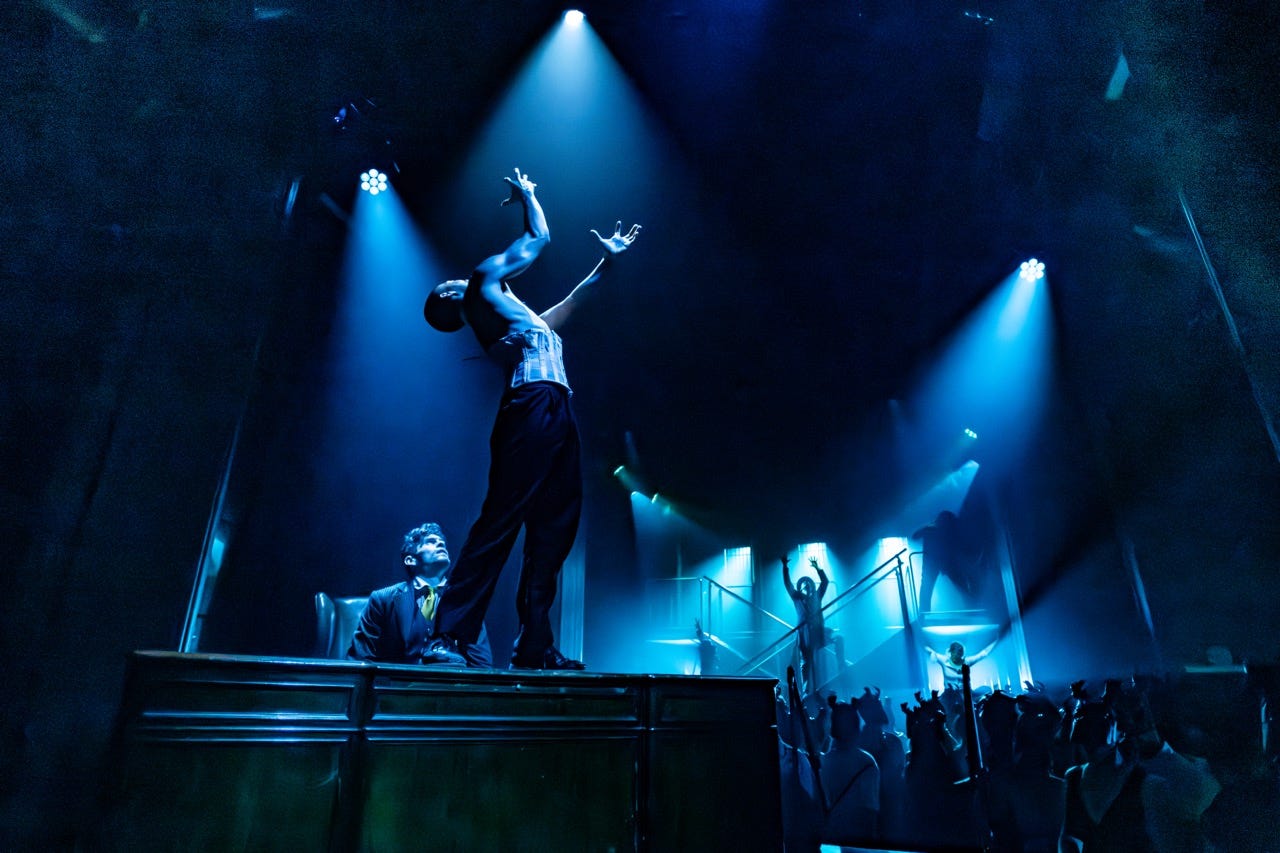
THE MOMENTS THAT HIT HOME
JOEY: At one point I stumbled upon a romantic moment between two female characters, taking place on some rocks by the water’s edge. The room was very dark, lots of haze. They partly undressed and sat by the water together. It was very sweet, and tender. And then eventually, one of them freaked out and ran off. And I was really moved by it, even though I had no idea who these people were.
So there were moments where it hit for me, despite the lack of narrative grounding. Were there any like that for you?
ALLIE: I don’t know. I feel like it was hard for me to move past just trying to understand what was happening.
The scene that I would take away and talk about from the show, I mentioned previously, which was the magic trick. But that leaned on spectacle. Which does work for this kind of story, the more they lean into spectacle, the more effective it is for audience literacy. But just spectacle for three hours is a lot.
CONSIDERING DESIGN
ALLIE: In terms of the set — what did you think?
JOEY: While there were small pockets of it that looked a little bit cheap, broadly I would say it was pretty fantastic.
There is a mood and an aura that they are trying to keep up from the moment you step into the building of a slightly unreal, heightened 1920s Art Deco thing, where they are looking for it to not just be a literal recreation of that period, but mixing in those aesthetics with this “descending into the depth of hell” vibe. And I was really impressed by how, for me, it never lost that mood. There was no moment where I stepped into a room and felt taken out of the world they were trying to build — it was consistent across the board.
ALLIE: They did a great job of building the physical world. Lots of really creative stuff, many things that were surprising and shocking and fun to see. Set design is, I think, where they were the most innovative. My only complaint about the set is how it worked with the choreography.
At the same time, some of my evidence of the show not putting its audience first comes through in the set. The sightlines battling against the architecture, for instance. Also just basic safety — no glow tape on the stairs, no markings of uneven surfaces… so I question that end of it.
Also, to follow any character, you do have to be athletic. You will find that unless you are the first trail-er hot on a performer’s heels, you’re gonna lose the track. There’s a significant amount of stairs and actors are running up and down. Which is typical of the form, but this just felt more intensely athletic.
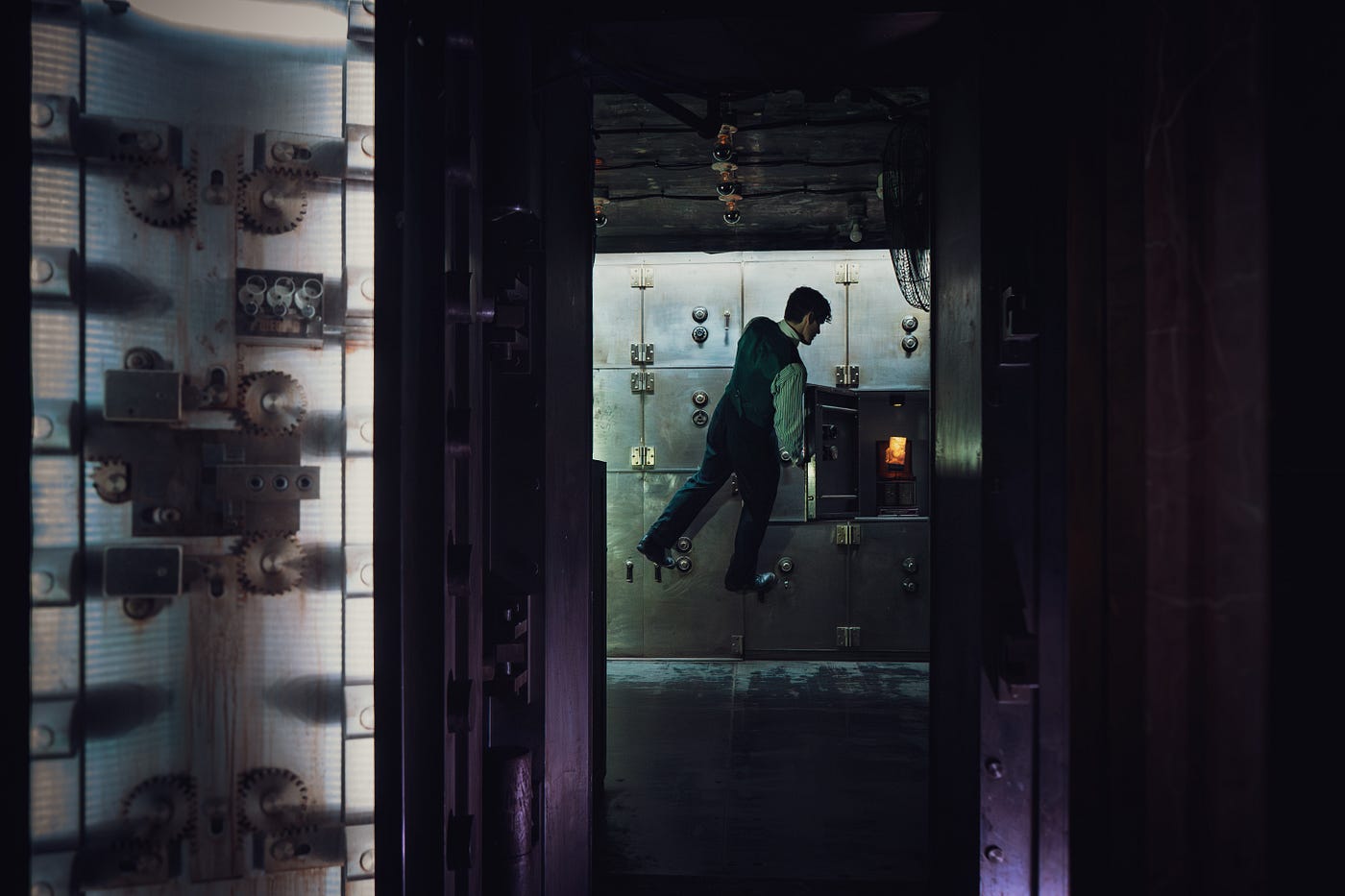
THE QUESTION OF ACCESSIBILITY
ALLIE: The show has been spoken about pretty highly in terms of widening accessibility, particularly for those audience members who have mobility assistance devices. I did see an audience member who was using a mobility device, and they had a dedicated docent with them, which was great to see. But this person was always the last into any room, and the last to leave. So there’s no opportunity to trail someone in an effective way, and you’re missing key parts of the action, and by the time you get in there, there’s not a sightline for you.
This is a larger question about the form: how can we make it accessible? It’s always nice to have a new offering of accessibility, but I would have loved to have seen more thought put into that, because it’s still missing the mark. Particularly when you’re paying the same ticket price as someone who was able to make their own choices, and able to fight their way to the front.
JOEY: I was not going to go sprinting out of a room, pushing past other people, just to try and be the first person behind a performer, I was never going to do that — leaving aside safety reasons, just because it feels like loser behavior. But there were people who were absolutely dedicated to doing that. As the night goes on, you start to clock exactly who they are, the ones who would happily push you down the stairs if they get to be first behind someone.
Obviously it’s inherent to the form that the actors are constantly on the move. But I didn’t understand why they would ever need to be running. Is that normal?
ALLIE: There’s usually some variety in the speed at which you can trail. If you go to Sleep No More, you’re not gonna trail Macbeth if you don’t wanna run. But there are other characters you could trail. In this, it felt like every character ran at some point. I was huffing and puffing.
JOEY: I think anyone, even a younger fitter person, is by the end — before you’ve even gotten to the finale– starting to feel like, ‘Oh boy, I’m kind of done.’ Which is not necessarily a place you want to get your audience to. It’s not like I was done with the show, I didn’t want to end — but I was feeling physically done.
ALLIE: Being physically done and yet feeling like you still haven’t gotten enough of the story… that was hugely problematic for me.
Two other accessibility notes I had. One is, you cannot really wear the mask with glasses. I opted to go without my glasses, and everything was just a little bit blurry for me. I can get by without mine, it’s just not preferable, but other people can’t. And that’s a solution we’ve seen, people have come up with that solution, so to not include it is blatantly ableist. That’s an accommodation you can and should be making.
JOEY: What is the solution?
ALLIE: For the Sleep No More masks, they put some foam over the nose and then it leaves room for your glasses. In the current version of Sleep No More, in the onboarding, they’ll note how many audience members have glasses on and they’ll give you the adapted mask. And that’s not a huge production cost.
My other accessibility concern is that the actual bar, the real bar, is quite hard to get back to when you’re new to the space. Full transparency, I was having a little low blood sugar at one point in the show, and I needed to go to the bar to get some juice, otherwise I was gonna pass out. I have type 1 diabetes, I will pass out and have a seizure. And I’d already eaten the two fruit bars I snuck in in my pocket.
The number of docents that I had to speak to to finally get back to the bar, it took a process of like 15 minutes. And they weren’t clear about whether I could re-enter or if I had to stay in the bar. People should be able to know that there is that space they can go back to, and it just wasn’t as available as it should have been.
JOEY: Absolutely. The bathrooms were fairly well marked, but it took me a while to notice or realize that there were actually a bunch of water stations all over the space. They were black, so they just kind of faded into the background.
ALLIE: It was also not clear to me what we had permission for. It would be easy to say in the onboarding, “There are bathrooms inside and there is water inside, please use them as you need them.”
Having those two things inside, that’s great accessibility — but it is almost saying that they want you to stay in the space. Whereas in other version of this format, they are just as happy if you’re in the bar. That’s an interesting thing.
JOEY: Maybe there needs to be a second home base location somewhere, somewhere aside from the coffee hall.
ALLIE: For the amount of budget that an experience like this has available to them, for the amount of network that this producing group has available to them, I expected more in terms of access. Again, it was another opportunity to be a thought leader in the field, and they didn’t take it.
JOEY: For all of the time and thought that they put into this show — years worth of it, including an additional two years because of the shutdown — so much could have been developed further.
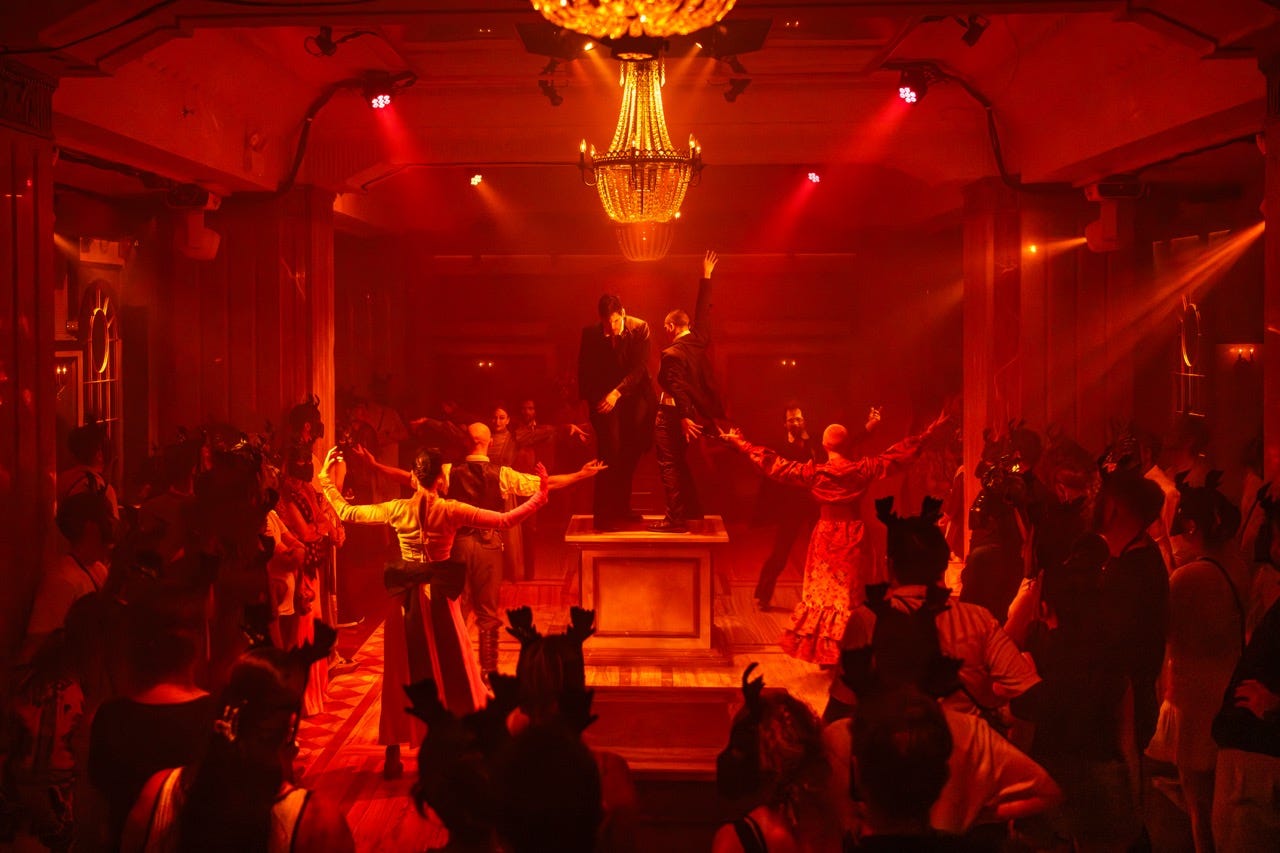
FINALE THOUGHTS
JOEY: I don’t need or expect a hugely complex thematic conclusion, I don’t mind if your condemnations of the cruelties of a capitalistic world are a little basic, given the broad picture that you’re painting. But even given that, I felt like they didn’t have any thematic surprises in store. It was like, yep, and here he is, suffering his punishment for everything you saw, and…that’s it. There’s no additional beat.
ALLIE: I think that’s a great critique, for me, of the whole show — it lacked that thoughtfulness to dare to be complex. To dare to be nuanced. It lacked the thoughtfulness to understand that this was an opportunity to develop the form instead of just copy/pasting it exactly as it exists. And we don’t often have opportunities for that on this large of a scale. There’s this overarching theme of being so, so close, and just missing the mark.
JOEY: I really thought, okay, as fragmented as this whole night has been for me, I have to assume that we’re gonna get to a big finale at the end where all these characters will come back into one space and this is going to, in some way, all tie back together. Not every bit that you saw, obviously, but somehow it’s all going to come into focus. And that does not happen at all.
ALLIE: Most of them aren’t even playing their characters in the finale.
JOEY: Yeah, they’re not the people who we’ve met, so none of those threads come together. Instead, there’s just a lot of dancing. Really good dancing!
ALLIE: Beautiful! Performers, killed it. Costuming, great. Set, great. Everything else…eeeuh. So, is that enough for a $130 ticket? That’s the question.
JOEY: That’s the question. My sense from the people around us in the finale was that, unfortunately, many of them seemed to feel pretty checked out by that point. They were exhausted by the physical aspects that we mentioned, and the finale lacked an emotional hook to grab them. So the vibe was like, they were ready for it to be done. And that was a shame.
ALLIE: It’s hard to feel that energy from the audience in the finale. I was marveling at the performers, but at that point the energy was not there.
JOEY: To end on a positive, for all I’ve said, there is still a part of me that wants to delve back into that incredible world they created and explore more of its nooks and crannies. So I’ll give it that.
ALLIE: If it was not so expensive, I’d love to see it again. Because yeah, the most effective storyline I got was in following one character. I’d like to do that for a couple more characters.
Discover the latest immersive events, festivals, workshops, and more at our new site EVERYTHING IMMERSIVE, home of NoPro’s show listings.
NoPro is a labor of love made possible by our generous Patreon backers. Join them today and get access to our Newsletter and Discord!
In addition to the No Proscenium website and our podcast, and you can find NoPro on Facebook, LinkedIn, YouTube, Instagram, and in the Facebook community also named Everything Immersive.